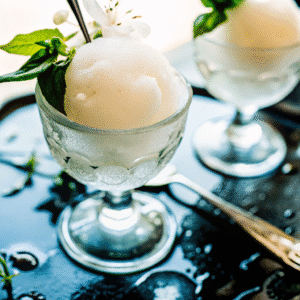Are you ready to dive into the delicate, floral world of honeysuckle? This honeysuckle sorbet recipe brings summer’s sweetest blossoms into your kitchen—no fancy skills required. You’ll learn how I first discovered this aromatic treat in my backyard, why it made such an impression, and exactly how simple it is to recreate at home. In just a few steps, you’ll turn foraged honeysuckle into a refreshing, light dessert that’ll surprise and delight. Let’s stroll through petals, memories, and flavor as we brew up this unforgettable frozen treat!

Honeysuckle Sorbet
Ingredients
- 4 cups fresh honeysuckle blossoms
- 2 cups water
- 1 cup sugar
- juice of 1 lemon
- pinch of cinnamon or splash of white wine optional
Instructions
- Rinse and sort the honeysuckle blossoms.
- Steep them in 2 cups cold water for 12–24 hours in the fridge.
- Strain and discard the flowers.
- Add sugar and lemon juice to the liquid, heat gently until sugar dissolves.
- Cool completely, then chill the mixture.
- Churn in an ice cream maker or freeze and scrape for granita.
- Transfer to container and freeze 2–4 hours before serving.
Notes
Steeping longer creates a stronger floral flavor.
Store sorbet up to two weeks.
Discovering Honeysuckle Sorbet
Floral Summer Memories with Honeysuckle Sorbet
I still remember standing barefoot on dewy grass as a kid, gently pinching honeysuckle blossoms and savoring their nectar. This honeysuckle sorbet recipe reminds me of those sun-warmed mornings full of laughter and sticky sweetness. With every spoonful, I bring back childhood joy and the feeling of summer’s lightness. Honeysuckle’s delicate floral notes—bright, sweet, and slightly citrusy—make it perfect for a sorbet that feels both nostalgic and sophisticated. I use this recipe to rekindle those memories, and I’m excited to share it with you.
Why Honeysuckle Makes a Perfect Sorbet
Honeysuckle flowers infuse water with a gentle fragrance that’s hard to beat. Unlike heavy cream-based ice creams, sorbet lets that light aroma shine through. The blossoms yield a subtle sweetness that balances beautifully with a splash of lemon or a hint of cinnamon. Plus, it’s an easy way to enjoy edible flowers—you don’t need candying skills or fancy tools. If you’re curious about foraging safely, check out my guide on foraging safety tips and learn how to spot edible species. And once you’ve mastered this, you can branch out—your next stop might be exploring creative edible flowers in dessert recipes!
Ingredients You’ll Need
What to Gather for Your Honeysuckle Sorbet
To make this delightful honeysuckle sorbet recipe, you’ll need just a handful of simple, seasonal ingredients: 4 cups of freshly picked, fragrant honeysuckle blossoms (without stems), 2 cups of water, 1 cup of granulated sugar, and the juice of one lemon. For a subtle twist, you can add a pinch of cinnamon or a splash of dry white wine—both enhance the blossoms’ floral undertones. To stay on track, check out my sugar-substitute options post, where I explore light-sweetening swaps that still let the honeysuckle shine. Using just these basics keeps the sorbet straightforward and true to the flower’s natural glow.
Sourcing and Selecting Honeysuckle Flowers
Harvesting safely is essential. Only pick edible honeysuckle species (Lonicera japonica and similar), and avoid red or trumpet varieties that might be toxic. The best blooms are newly opened, not wilted or discolored. Gently shake each cluster to remove any tiny insects and rinse blossoms in cold water right before use. For more on identifying safe plants, my edible flowers guide offers useful photos and tips you’ll find helpful. If you’re foraging for the first time, pair that with my foraging safety tips to help you recognize good specimens and respect nature’s balance.
With ingredients in place and flowers carefully chosen, you’re all set for the infusion stage. Next up we’ll dive into how to extract that fragrant essence and transform it into irresistibly smooth sorbet. Just as Marie in my ice-cream-making guide found, a little patience with the infusion pays off in big flavor rewards. Let me know if you’d like the infusion step now!
Step-by-Step Preparation
Infusing the Blossoms Overnight
Start by placing your freshly rinsed honeysuckle blossoms into a large glass bowl. Pour 2 cups of cold water over them, making sure the flowers are fully submerged. Cover the bowl with a lid or plastic wrap and refrigerate the infusion for 12 to 24 hours. This slow, cold steeping process draws out the delicate floral aroma without cooking away the freshness. I’ve found that the longer you let it steep, the stronger and more nuanced the flavor. Once infused, strain the liquid through a fine mesh sieve or cheesecloth, pressing gently on the blossoms to release every last drop of that golden nectar. Discard the spent flowers—they’ve done their job beautifully.
Making Syrup + Churning Your Sorbet
Now that you’ve got your honeysuckle-infused water, it’s time to build the sorbet base. In a saucepan, combine the infused liquid with 1 cup of sugar and the juice of one lemon. Heat gently over medium heat, stirring until the sugar dissolves completely—don’t boil it. If you’re using cinnamon or a splash of wine, stir that in now. Let the mixture cool fully, then chill it in the fridge for at least 2 hours.
Next, pour it into your ice cream maker and churn according to the manufacturer’s instructions. If you don’t have one, no worries—follow my ice-cream-making guide for no-churn alternatives. You can also freeze it in a shallow tray and scrape it with a fork every 30 minutes to make a refreshing granita. For a silky texture and easy scooping later, transfer the churned sorbet into a container and freeze it for 2–4 hours before serving.
Finishing Touches & Serving
Curing and Storing Your Sorbet
Once your honeysuckle sorbet finishes churning, it needs time to “cure” in the freezer. Transfer it into a shallow, airtight container, smooth the top, and freeze for at least 2–4 hours. This final freeze firms it up and deepens the floral notes. Sorbet is best served within the first week, while its texture is still smooth and scoopable. After about 10 days, you might notice some crystallization, but a quick stir before serving brings it back to life. If you’re curious about shelf life and scoopability, check out my frozen dessert tips on the recipe card page, where I break down freezing stages for sorbets and granitas.
Serving Suggestions & Variations
Honeysuckle sorbet shines in a chilled glass, garnished with fresh mint or a twist of lemon zest. You can serve it between courses as a palate cleanser or alongside summer berries for a refreshing dessert. Feeling festive? Pair it with a splash of prosecco or white wine, like Fresh & Foraged suggests—it transforms the sorbet into a dreamy float perfect for garden parties. Want to add flair? Drizzle with elderflower syrup or plate it next to a buttery shortbread cookie. For more ideas, visit my summer cocktails pairing post and plating tips section where I share inspiration for beautiful presentations.
This recipe is flexible and seasonal—substitute honeysuckle with other edible flowers like lilac or elderflower when available. The key is respecting the bloom’s essence and letting it speak through gentle preparation. Now that you know how to make, store, and serve this floral gem, it’s time to answer some of your top questions about honeysuckle!
FAQs
Can you make anything out of honeysuckles?
Yes! Honeysuckle isn’t just fragrant—it’s versatile in the kitchen. You can make honeysuckle syrup, jelly, tea, or even use the blossoms to infuse water, lemonade, or this honeysuckle sorbet recipe. Just be sure you’re using an edible variety like Lonicera japonica.
How to make honeysuckle sugar?
To make honeysuckle sugar, layer fresh, dry honeysuckle blossoms with granulated sugar in an airtight jar. Let it sit in a cool, dry place for about a week, shaking gently every day. Strain out the flowers and use the perfumed sugar in baking or tea.
Is honeysuckle an ice cream flavor?
Yes, it can be! While it’s more common in sorbet due to its delicate floral profile, honeysuckle can also flavor custard-based ice creams. The key is gentle infusion so the subtle notes don’t get lost.
How to prepare honeysuckle?
To prepare honeysuckle, first identify the edible type, then harvest blossoms that are fresh and fully opened. Rinse gently in cold water and remove any green stems. Use the flowers immediately for best flavor or steep them in cool water to extract their aroma.
Conclusion
Honeysuckle sorbet isn’t just a dessert—it’s a celebration of summer’s fleeting floral magic. Whether you’re reminiscing about childhood afternoons sipping nectar from blossoms or discovering honeysuckle’s charm for the first time, this recipe brings a gentle, fragrant touch to your table. With just a few ingredients and a little patience, you can turn backyard blooms into a showstopping treat that’s light, refreshing, and surprisingly easy.
If you loved this honeysuckle sorbet recipe, explore more floral favorites in my Pinterest. Have a serving suggestion or favorite variation? Drop it in the comments—I’d love to hear how you made it your own!


